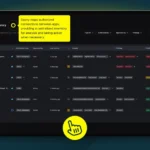SaaS (software as a service) solutions are part of the ever-growing cloud ecosystem for most businesses. By the end of 2024, it is predicted that 99% of companies will use at least one SaaS solution as part of their IT ecosystem. While these solutions fulfill on-demand software needs, with most requiring commitments of no more than a year, they come with security challenges for organizations using them. The very nature of SaaS requires businesses to turn over the majority of security management to the SaaS provider, leaving them a crucial set of controls to manage access and authentication. Failure to properly configure and manage these settings can expose organizations, allowing attackers easy access to the data contained in these products.
What is SaaS Security Posture Management?
SSPM (SaaS Security Posture Management) is a set of automated tools for securing SaaS applications that identifies and mitigates risks like misconfigurations, excessive user rights, and compliance issues. SSPM works by continuously monitoring SaaS applications, examining user permissions, compliance with data security laws and configurations, alerting security teams about potential risks, and can often automatically rectify many issues. It is a fundamental security component for businesses using SaaS to ensure their settings are correctly configured and managed.
What are the Benefits of SSPM?
SSPM tools help organizations overcome many security challenges associated with SaaS utilization. They provide a depth of visibility across multiple SaaS solutions, amalgamating data in one location and allowing organizations to manage and monitor their SaaS security posture from one location rather than navigating each product’s management page.
Monitoring is one of the core features of SSPM. Instead of a static, point-in-time security analysis, these tools constantly scan for security risks and compliance issues, alerting teams as soon as they arise. They also automatically detect potential vulnerabilities such as misconfigurations, inactive user accounts, and excessive user privileges. This continuous vigilance allows for immediate action, enabling teams to address risks before they escalate.
It builds on monitoring by ensuring that SaaS applications adhere to data security and privacy laws and conducting thorough compliance checks to meet regulatory standards. Part of how it does this is through meticulously managing user permissions within these applications. By analyzing and regulating who has access to what, SSPM effectively identifies and corrects instances of excessive or inappropriate access rights. This dual focus enhances the security of sensitive data within SaaS environments and ensures that user access is aligned with organizational policies and legal requirements.
SSPM tools drive automated remediation when issues are discovered, swiftly and efficiently resolving identified security risks without manual intervention. They push alerts to security teams about potential threats and provide comprehensive reporting, enhancing overall visibility and management and allowing for a more coordinated and effective response to security challenges in SaaS environments.
What are the Challenges of SSPM?
SSPM tools are not without their challenges, though. These tools must manage complex security across many known and sanctioned SaaS applications, each with unique configurations and settings. This requires a nuanced understanding and tailored approach for each application. While doing this, they must keep pace with rapid changes and updates in these SaaS applications. These frequent modifications can directly impact security configurations, necessitating a dynamic and responsive approach to maintain effective security measures continuously.
SSPM’s intersection of visibility, compliance, and user management presents a unique set of challenges. Achieving comprehensive visibility and control over the security settings of various SaaS applications is crucial for effective management. Simultaneously, ensuring these applications continuously comply with evolving data protection and privacy regulations is a dynamic and ongoing process. Additionally, monitoring user behavior, particularly in large organizations with numerous users, is essential for managing access and permissions effectively. It is important to note that all SSPM monitoring and visibility generally only extends across known SaaS applications. Shadow or business-led SaaS applications will be missed by most SSPM tools, leading to gaps in visibility and control.
The last and most significant challenges of SSPM come from integrating SSPM with existing security infrastructure to achieve cohesive and seamless security management, as it requires compatibility and effective communication between different systems. This integration is crucial for effective automated remediation. While this automation addresses many security issues, it still needs human oversight to ensure that automated actions are appropriate, align with the organization’s broader security policies, and handle complex situations where human judgment is crucial.
How Savvy Helps
SaaS does not have to be complicated to manage and secure. Discover how Savvy leverages SSPM to enhance your organization’s SaaS security. Savvy helps organizations safely embrace decentralized SaaS utilization, guiding users toward proper security hygiene and allowing the business to drive SaaS adoption without the encumbrance of security halting or slowing it down.
With Savvy, organizations still maintain control of their SaaS landscape without friction. Savvy automatically engages with end users or APIs to remediate risks at scale. It continuously monitors for security misconfigurations, user permissions, and adherence to compliance mandates.
Try a demo today to discover how Savvy can quickly and easily secure your SaaS applications against emerging threats and protect your data without adding user friction.
FAQ
What is the difference between SSPM and CASB?
- SSPM focuses specifically on securing SaaS applications by managing their security postures. Alternatively, CASB offers broader security across various cloud services, including SaaS, PaaS, and IaaS, by acting as a policy enforcer between users and cloud providers.
What is security posture management?
- Security posture management is assessing, improving, and maintaining the security level of an organization’s IT infrastructure and services.
What strategies do SSPM tools employ to keep up with rapid updates in SaaS applications?
- SSPM tools keep up with rapid updates in SaaS applications by employing automated continuous monitoring and integrating with SaaS APIs, which enables them to adapt quickly to new changes and maintain security configurations effectively.


